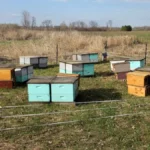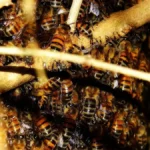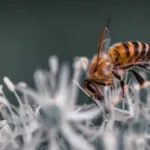In this article, we look at how to protect beehives from bears. This starts with the simplest of steps – methods to keep bears away from the bees. Should these methods fail, we look at the second line of defense, protecting your bees from the bears.
Who Contributes To This Problem?
A beehive represents a concentrated form of energy (honey) and protein, vitamins, probiotics, and fat (bee brood and pollen).
A beehive, being full of all these good things, is consequently of extreme interest to humans, honey badgers, baboons, and bears. I have listed this specifically in order because in my experience the human is the most difficult creature to protect hives against.

Read more about: How Much Do Beehives Cost?
Humans As An Apiary Threat
Forget bears, or anything else. A human is a clever, social, devious, technologically assisted pest. We are an infernal species, and when we go bad, we go really bad. If you can protect your hives against humans, you can protect your hives against anything. In areas where human social cohesion is low, some humans rob beehives from other humans.
Beekeepers develop technologies, some legal, some not, to protect their hives. These technologies are more than adequate to protect against bears, given that bears do not know how to use bolt cutters, pickup trucks, and gas masks.
Humans can raid thousands of hives. There are records of tens of thousands of hives being stolen by bee rustlers around the world from California to Germany to South Africa.
Honey Badgers As An Apiary Threat
A honey badger is more intelligent, tough, and determined than almost any other animal on Earth (bar humans and some weird thing from Australia that is nearly extinct).
Honey badgers are very strong and can take a full bite from a cobra (so one or two thousand beestings are of little consequence). Luckily they are largely solitary animals and are not malicious. They attack one hive at a time. If you are vigilant you can limit the damage.
Baboons
A baboon is basically like a drunk high school jock on crystal meth. It is incredibly strong, has a malicious sense of curiosity, and derives a sense of joy out of destruction. A baboon will find a way to bypass and destroy things just because there are things to bypass and destroy.
Baboons travel in large groups and when 50 or 60 baboons decide to see who can throw the most beehives into a tree, over a cliff, or into a river, your apiary is doomed.
Bears
Bears are largely solitary predators. They are big shuffly animals who will tip beehives over, smash the boxes and eat the brood and honey. The damage bears can cause if they are given the time is incredible.
In parts of the US and Canada, the single largest cause of bee loss is bear damage. This is a lovely opportunity for all of us to work together and use the technologies which we have developed in different parts of the world, to deal with different pests, and to deter bear damage in North America.
The Importance Of The Environment/Bear/Bee Overlap
Significant parts of the world are so polluted and damaged that keeping bees in these areas for long periods of time actually damages the bees. For these reasons, we need parts of the world to be wilderness areas, and in North America a wilderness needs bears. Bears spread berry seeds and all the things that bees pollinate, so to enhance the bee carrying capacity of a wilderness area, bears are a cornerstone species.
We view a wilderness area as being a bit like a spa for bees. A place for bees to get back in touch with biodiversity, and recover from being forced to eat Monoculture pollination contracts. It is a bit like a human being sent from a diet of fast food to an organic farming commune. Here they eat homegrown vegetables, meat, eggs, honey, and fruit. Within a week of such a “wilderness” diet, a human or a bee gets a twinkle in their eye
If we combine the knowledge that people around the world have developed to protect against all of the above threats, we can work out a practical set of solutions to deal with bear problems around bees.
In this article, we will look at the ways people protect against bears in parts of the world where bears exist. Being part Canadian I have had experience with bears and their impact on bees, and living in Africa I have also had experience with the remainder of the scary creatures that can rob beehives listed above.
Conservation and Changing Land-Use Patterns
My general feeling is that as bear populations increase with changing land use and conservation patterns in North America, there will be a need to transfer knowledge from other parts of the world where even more irritating animals exist.
As conservation becomes a more common land use pattern, we will find that more beekeepers will be forced to move to “conserved” land as the biodiversity and health this land provides bees is attractive and will help combat colony collapse disorder.
This will place more and more beekeepers in conflict situations with bears.
First Line Of Defence- Protecting Bees From Bears
An electric fence. These are effective deterrents for most animals.
Types Of Electric Fence
The Wrong Types
You get the little electric fence that gives a little tickle when you touch it. These are great for dealing with animals that are easily scared and have thin fur. Bears are not these animals. Low voltage, low joule fences will just irritate the bear.
You also get “weed burner” fences which are designed to pulse through and burn weeds that touch the fence. These start fires and are not welcome in the wilderness.
The Right Type
You essentially want a “hits you so hard you poop your pants” fence.
Bears have thick fur and you need enough voltage to get through the fur. Once the voltage has penetrated the fur it also needs the stopping power to actually do something educational to the bear. This is the joule rating. For an excellent article explaining exactly how this works, go here.
Read more about: How To Raise Honey Bees For Profit
Second Line Of Defence- Making Bear Proof Bee Hives
Hive Strapping
When a hive is strapped to a secure stand, such as a pallet, it is more difficult to knock over. A few hives strapped to one pallet have a beneficial effect as irritating one hive will wake the other hives up. Bears can actually feel stings, and if enough bees get angry they will cluster on the eyes and nose of the bear and the experience will become increasingly unpleasant for the bear.
Shipping Containers
A 20 or 40″ shipping container is an impenetrable fortress for bees.
Electric fences get stolen. It is more difficult to walk away with a locked shipping container with 100 beehives inside.
Typically, holes are cut for the hive entrances, and the hives are places on brackets inside the container. Ventilation holes with roof turbine vents keep the container ventilated.
Bees thrive in shipping containers, and it is relatively easy to work hives in these spaces. The weatherproofing advantages are also great.
Learn more about: What Does A Honey Bee Hive Look Like?

Dr. Garth A. Cambray is a Canadian/South African entrepreneur and beekeeper with 28 years of experience in apiculture and specializes in adding value to honey. His Ph.D. research developed a new advanced continuous fermentation method for making mead that has resulted in a number of companies globally being able to access markets for mead. His company, Makana Meadery, exports honey mead to the USA where it is available to discerning connoisseurs. He has also developed technologies to commercially manufacture organic honey vinegar in Zambia for export globally. He holds a few patents globally in the ethanol industry and believes in technology and knowledge transfer for human development and environmental sustainability. One of his proudest achievements is the fact that the wind farm he started at one of his old apiary sites has essentially made his hometown carbon neutral.






